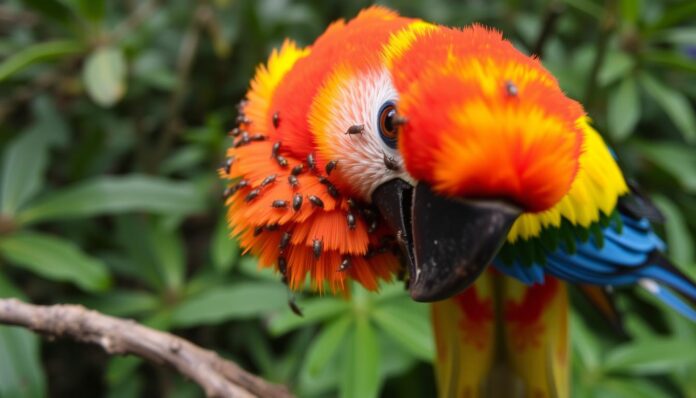Pigeons and seagulls often carry fleas, which can spread to other birds and pets. This shows why controlling bird parasites is key. It’s important to know if birds can get fleas and how to stop infestations.
Cleaning around a bird’s cage often is vital to fight fleas. Also, pets like dogs and cats need flea treatments to avoid getting fleas from birds. This shows we must tackle bird flea problems from all angles.
Fleas can move from birds to pets and back again. This makes it critical to deal with bird flea issues. By learning about bird parasites, we can protect birds and stop fleas from spreading.
Understanding Bird Fleas and Their Impact
Bird fleas are a big problem for bird health. Knowing how they work is key to keeping birds safe. Fleas can spread diseases and make birds very uncomfortable. It’s important to check birds often and keep their living areas clean.
There are many kinds of fleas that bother birds. For example, the poultry Stickfast Flea sucks blood from birds. Fleas go through many stages, from eggs to adults. To manage fleas, we need to understand each stage of their life cycle.
Pigeons, seagulls, and other birds are often hosts for fleas. Knowing which birds fleas like helps us find ways to stop them. By focusing on bird health and pest control, we can lessen the harm fleas cause.
Types of Fleas That Affect Birds
- Poultry Stickfast Flea
- Other flea species that affect birds
The Biology of Bird Fleas
The life of bird fleas is quite complex. They go through many stages, from egg to adult. Knowing this helps us find better ways to stop them.
Common Host Species
Pigeons, seagulls, and other birds often get fleas. Understanding these birds and their habits is key to keeping them flea-free.
| Host Species | Flea Species |
|---|---|
| Pigeons | Poultry Stickfast Flea |
| Seagulls | Other flea species |
Can Birds Get Fleas? The Definitive Answer
Birds can get fleas, but it’s less common than in dogs and cats. The Stickfast Flea is the most common flea in birds. It attaches to birds and sucks their blood. Bird flea treatment often uses ivermectin or moxidectin, killing fleas after they attach.
It’s key to know the difference between bird fleas and other fleas. Bird parasite control methods depend on the flea type and infestation level. In poultry, Stickfast Fleas can cause severe anemia.
To stop fleas, keep things clean and check birds for fleas often. Bird parasite control methods include topical or oral treatments and cleaning the bird’s area. Knowing the risks and taking steps can help keep birds healthy and flea-free.
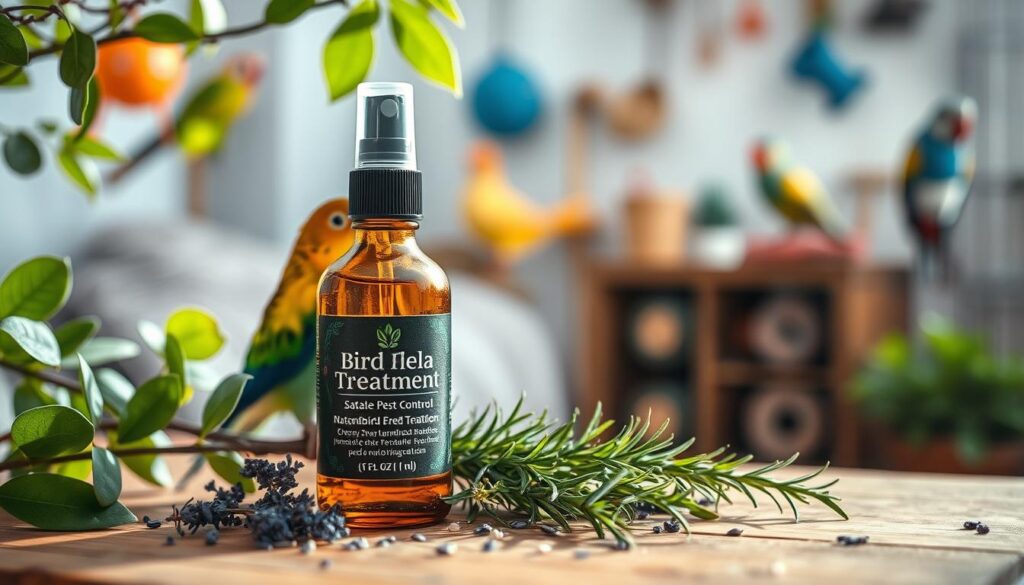
It’s also vital to watch for mites and lice in birds. Bird parasite control methods might use ivermectin and moxidectin together. This helps manage infestations effectively.
| Parasite | Type | Treatment |
|---|---|---|
| Fleas | Stickfast Flea | Ivermectin or moxidectin |
| Mites | Cnemidocoptes | Ivermectin or moxidectin |
| Lice | Feather lice | Avian Insect Liquidator |
Signs of Bird Flea Infestations
Bird flea infestations show up in different ways. You can see them, notice changes in behavior, and spot signs in the environment. Bird flea identification is key for managing bird pest management. Birds may scratch or preen more than usual, up to 2 to 3 times.
Some common signs of bird flea infestations include:
- Itchy, damaged skin and feathers
- Weakness from blood loss
- Feather plucking
- Changes in appetite
These signs mean a bird might have a bad flea problem. It could make the bird weaker, affecting its ability to fly or find food. Bird health concerns from fleas show why quick bird pest management is needed.
Environmental factors also play a role in bird flea infestations. Wild birds, like those in communal nests, are more likely to get infested. Even domestic birds, like chickens and pets, can get fleas. It’s important to have good bird pest management to keep birds healthy and happy.
Health Risks Associated with Bird Fleas
Birds can carry over 60 diseases that can be passed on to others. This makes bird health concerns a big deal. Bird fleas can cause anemia, mainly in young birds. This shows why bird flea prevention is so important.
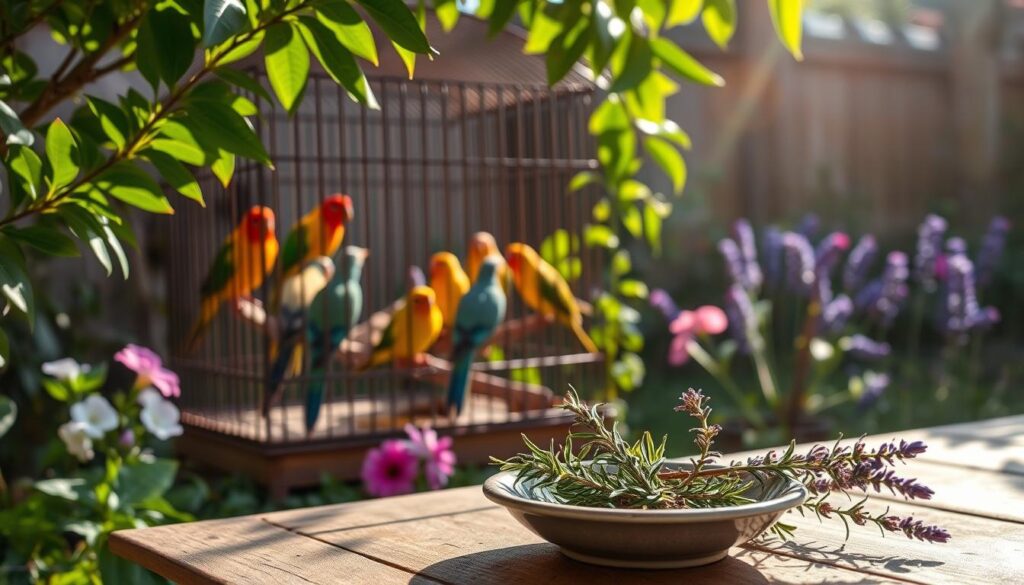
Birds also carry over 50 types of parasites. These can spread to humans, raising health risks.
Some health risks from bird fleas include:
- Anemia and blood loss
- Transmission of diseases such as Avian Influenza and Histoplasmosis
- Infestations of ectoparasites like ticks, mites, and lice
To lower these risks, regular bird parasite control is key. Keep environments clean, remove nesting sites, and use treatments as a vet suggests. These steps help protect both birds and their owners from bird flea health risks.
The Life Cycle of Bird Fleas
Understanding the bird flea life cycle is key for good bird pest management. Bird fleas go through four stages: egg, larva, pupa, and adult. The female lays her eggs in the bird’s nest. These eggs hatch into larvae in 3-4 days.
The larvae eat detritus and leftovers, not blood. The larval and pupal stages last 3 to 4 weeks. After that, adult fleas come out. These adults are 2-5mm long and can live months.
Bird flea biology is important for understanding their life cycle. Knowing the stages helps bird owners and pest control experts manage bird pests better.
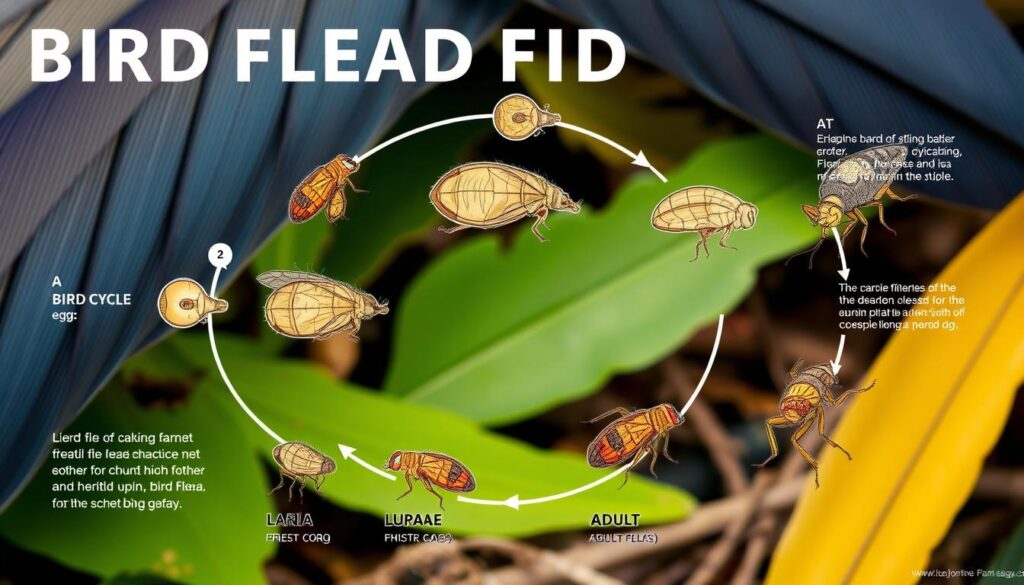
Egg Stage
The egg stage is the first part of the bird flea life cycle. The female lays her eggs in the bird’s nest. These eggs are white, oval, and about 0.5mm long.
Larval Development
The larval stage is the second part. Larvae eat detritus and leftovers, not blood. This stage lasts about 3-4 weeks.
Adult Flea Characteristics
The adult stage is the last part. Adult bird fleas are 2-5mm long, brown or reddish-brown, and flat. They have six legs and can jump far.
Prevention Methods for Bird Flea Control
To stop bird fleas, we need to use many ways. This includes keeping the area clean, checking often, and using natural ways to keep fleas away. These steps help avoid the need for bird flea control.
Keeping the area clean is key to stop bird fleas. Make sure there’s no mess or debris that fleas might like. Clean and disinfect bird homes and remove places where fleas might hide.
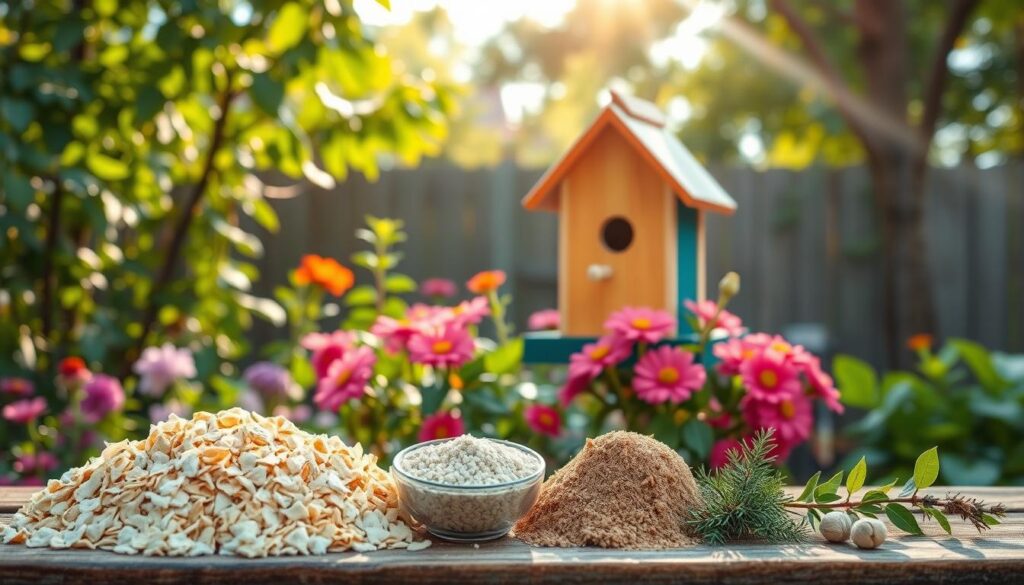
Regular Inspection Routines
Checking birds and their homes often is important. Look for signs like too much scratching or losing feathers. Also, search for flea eggs, larvae, or adults in the area.
Natural Deterrents
Natural ways like diatomaceous earth can help too. It’s a powder that dries out fleas and kills them. It’s a safe choice instead of using chemicals.
Using these methods can help a lot. Regular checks and keeping the area clean can spot problems early. Natural deterrents like diatomaceous earth are safe and work well to control fleas.
| Prevention Method | Description |
|---|---|
| Environmental Management | Keeping the environment clean and free of debris |
| Regular Inspection Routines | Monitoring birds for signs of fleas and inspecting the environment for flea eggs, larvae, or adult fleas |
| Natural Deterrents | Using diatomaceous earth to dehydrate and kill fleas |
Treatment Options for Bird Flea Infestations
Dealing with bird fleas needs a full plan to keep birds healthy. Bird parasite control methods include medicines like ivermectin, moxidectin, and pyrethrin sprays. Always talk to a vet to find the best treatment for your bird.
Here are some ways to treat bird flea problems:
- Medications: ivermectin, moxidectin, and pyrethrin sprays
- Environmental management: clean and disinfect the bird’s area and around it
- Regular inspection routines: watch the bird’s health and catch flea signs early
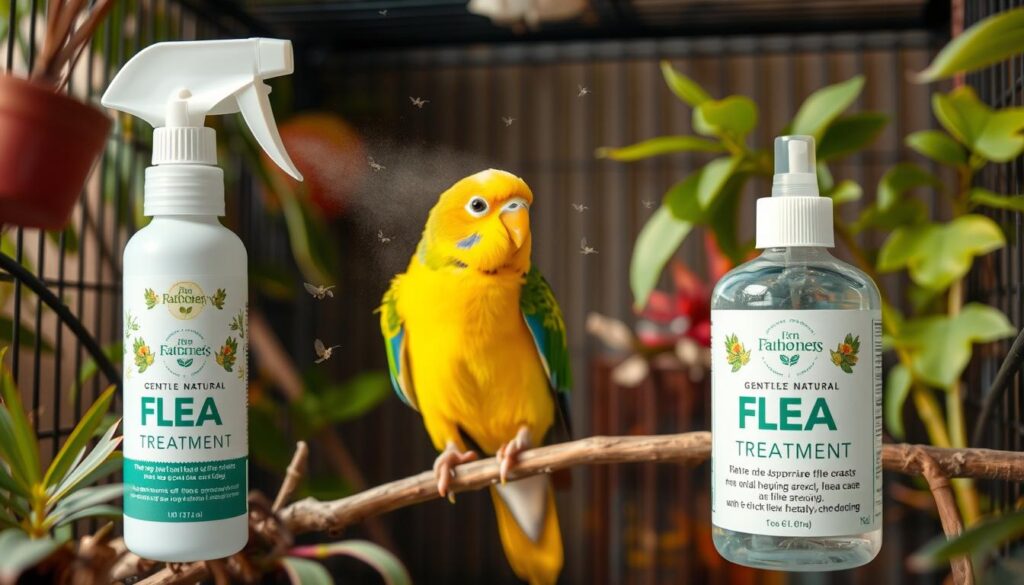
Using good bird flea treatments and control methods helps stop diseases. This keeps birds healthy and happy.
| Treatment Option | Effectiveness | Safety |
|---|---|---|
| Ivermectin | High | Generally safe when used as directed |
| Moxidectin | High | Generally safe when used as directed |
| Pyrethrin sprays | Moderate | Generally safe when used as directed, but may cause skin irritation in some birds |
Knowing the treatment options and being proactive helps bird owners. This way, they can protect their birds from flea dangers. It ensures their health and happiness.
Protecting Wild Birds and Aviaries from Fleas
Keeping wild birds and aviaries safe from fleas is key to stop disease spread and keep birds healthy. To prevent flea infestations, a mix of professional methods and changing the habitat is needed. Changing the environment to make it less likely for fleas to infest is a good way to start.
Protecting wild birds and aviaries from fleas involves several steps. Using 18 gauge wire for aviaries helps keep predators out. Also, burying wire in a 12” deep and wide trench stops digging by predators. Adding a screen over aviary wire keeps mosquitoes out too.
Cleaning aviaries regularly is also important to stop disease spread. But, it’s vital to avoid harmful toxic substances. Instead, natural options like boric acid can control pests. Creating a safe and healthy space for birds requires careful planning and effective prevention methods.
| Strategy | Description |
|---|---|
| Modify environment | Reduce likelihood of flea infestations by modifying the environment |
| Use 18 gauge wire | Provide sufficient protection against predators |
| Bury wire in trench | Prevent digging by predators |
| Install screen over aviary wire | Prevent mosquitoes from entering the aviary |
By using these strategies, we can keep wild birds and aviaries safe from fleas. This ensures their health and well-being. Effective control methods and prevention techniques are critical for bird safety in aviaries and the wild.

Conclusion: Maintaining Flea-Free Bird Environments
Keeping birds free from fleas is vital for their health. Regular checks, deep cleaning, and using bird flea prevention methods are essential. Studies show that using both topical treatments and oral medications can get rid of fleas. This should be done with a vet’s advice.
Good bird health also helps prevent fleas. Feeding them right, keeping them clean, and regular vet visits are important. Preening, feather molt, and the environment’s humidity can also help manage fleas. By being careful and using a wide range of strategies, bird lovers can make a safe space for their birds.
FAQ
Can birds get fleas?
Yes, birds can get fleas. There are fleas like pigeon fleas and poultry fleas that target birds. These fleas can harm the health of birds.
What types of fleas affect birds?
Birds face various flea species, including pigeon and poultry fleas. These fleas live on birds and can cause health issues.
What are the signs of a bird flea infestation?
Signs of fleas on birds include fleas, eggs, or droppings. Birds may also scratch a lot, pull out feathers, and eat less.
What health risks are associated with bird fleas?
Bird fleas can lead to serious health problems. These include anemia and blood loss. They can greatly affect a bird’s health and behavior.
How can bird flea infestations be prevented and treated?
To prevent fleas, keep the environment clean and check for signs often. Use natural deterrents. For treatment, medications, sprays, and other methods can be used based on the infestation’s severity.
How can wild birds and aviaries be protected from fleas?
Protecting wild birds and aviaries from fleas needs a detailed plan. Use professional methods, modify habitats, and manage pests. Keeping the area clean and flea-free is key for their health.


